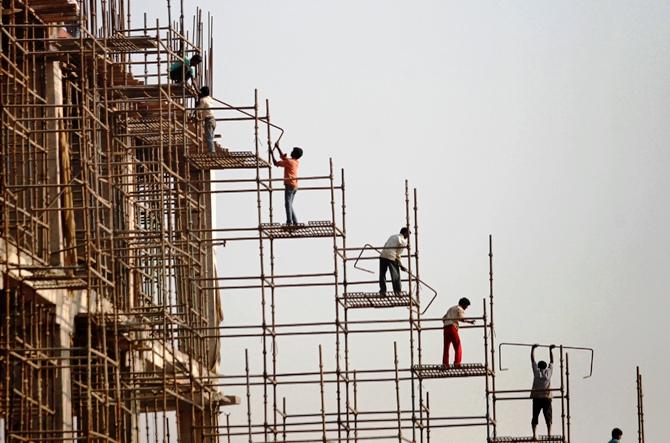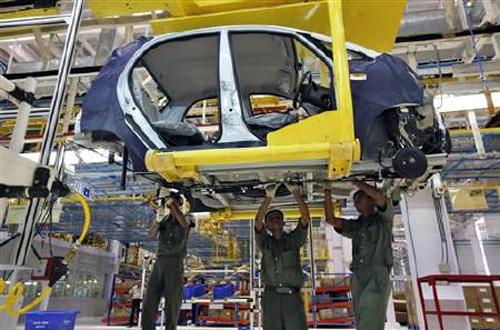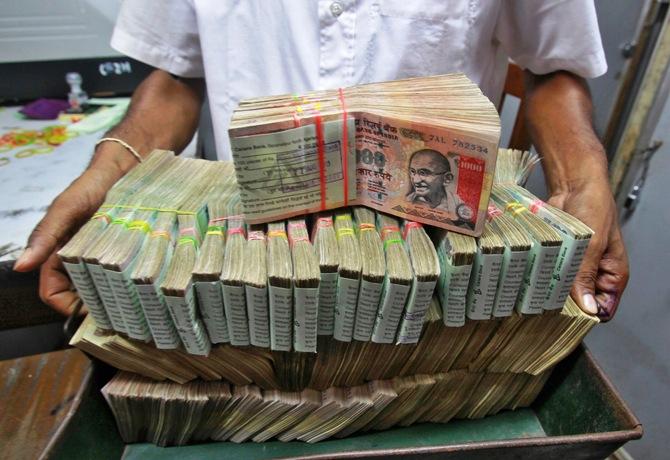Photographs: Reuters Alok Sheel
Fix agriculture to target food inflation, create labour-intensive manufacturing to target the current account deficit, and fiscal restructuring can target the infrastructure deficit.
The Indian economy is in trouble. India recently lost its traditional rank of the second fastest growing G20 economy to Indonesia.
With major imbalances and a sharp decline in growth, the challenges facing it are daunting. However, it needs to be understood that these are quite different from those of other major emerging markets.
While the imbalances have declined over the last few months, this is largely because growth has settled at a much lower trajectory than in the recent past.
For these reasons, unlike 1997 and 2008, India recently found itself within the polar vortex of the currency crisis sweeping emerging markets in the wake of the quantitative easing 'taper tantrums'.
What are the critical factors underlying a sustainable recovery to high growth over the medium term?
…
How India can fire itself back to high growth
Image: Labourers work at the construction site of a commercial complex in New Delhi.Photographs: Anindito Mukherjee/Reuters
Although the prospects for a robust global recovery over the medium term are still downbeat in view of the major demand re-balancings required, there is more cause for optimism regarding India, for two good reasons.
First, the two major drivers that recently pushed Indian trend growth from the 5.5-6.5 per cent into the 8-9 per cent trajectory are intact. The dependency ratio continues to decline, while the roughly ten per cent increase in domestic savings as a share of GDP is largely intact but for some short-term damage to financial savings.
Second, the rather startling fact is that in a demand-constrained world India has the luxury of a domestic crisis caused by supply-side problems. Unlike other emerging markets, dependent on external levers for a return to high growth, our levers are mostly domestic.
Since the supply-side crisis is of our own making and not a result of any major external shock, the solutions are also within our control. This will not be easy. Pulling these domestic levers is the big political challenge ahead.
…
How India can fire itself back to high growth
Photographs: Reuters
The three critical levers, or the three big arrows that need to fire, are agriculture that targets the inflation problem, labour-intensive manufacturing that targets the current account deficit, and fiscal restructuring that targets the infrastructural deficit.
If these three arrows can be fired accurately from a crossbow called good governance, they can address current macro-economic imbalances and lay the foundations for a return to a sustainable high growth trajectory.
At a time when inflation trends are becoming globally aligned, the persistence of high inflation in India seems a trifle puzzling. The global trend is presently deflationary. If food inflation is the villain of the piece, it is worth noting that global food prices have been subdued. Why is India an outlier?
Indian food prices have traditionally been lower than global prices. International trade cannot therefore be expected to dampen domestic food inflation. The roots of Indian food inflation are domestic, the result of market failure.
…
How India can fire itself back to high growth
Image: A farmer works at a sunflower field.Photographs: Reuters
This should not come as a surprise, because agriculture is the one sector which has yet to reap the efficiency gains from the opening up and liberalisation of the Indian economy since the early nineties.
Cereal inflation has increased because of repeated sharp spikes in the administered support prices for, and public stocks in, the large-scale procurement programme. This has negated the deflationary pressures from the demand shift away from cereals to non-cereal food items on account of rising incomes.
Non-cereal inflation has increased because of an antiquated marketing system and infrastructure that leads to low levels of productivity, large amounts of wastage and big mark-up in prices between the farm and final consumer.
The price signalling mechanism that equates supply and demand is consequently weak. The agriculture arrow needs to address these fatal flaws in the agricultural sector and working of agricultural markets. Controlling for technology, Indian agriculture has a global comparative advantage that is waiting to be unlocked.
…
How India can fire itself back to high growth
Image: Nano car plant Sanand.Photographs: Reuters
The second arrow should create a conducive environment to leverage India's comparative advantage in labour-intensive manufacturing.
This would facilitate the transfer of large numbers of underemployed workers stuck in low-productivity agriculture to high-productivity manufacturing, thereby raising incomes and absorbing the large projected additions to its labour force.
India enjoys the same advantage as China in manufacturing, with the added advantage of stronger private entrepreneurship and more developed capital markets.
With competitive frameworks in land, labour, tax, skill development, education, and governance, there is no reason why Indian manufacturing cannot plug into globalisation the way China has. This would also help address India's current account imbalance.
The third brahmastra is fiscal reform that targets not so much the level as the composition of India's structural budget deficit. There is avoidable confusion regarding fiscal reform in India because we do not distinguish between cyclical and structural budget deficits.
…
How India can fire itself back to high growth
Image: A man collects currency notes at a bank.Photographs: Reuters
Ceteris paribus, falling growth increases the budget deficit through a negative revenue shock, and vice versa. In either case the structural balance does not change.
The last thing that policy makers should do is aggravate an economic slump by cutting back government demand when private demand is slack, or increase expenditure when growth is above trend, to keep the nominal fiscal deficit unchanged.
While on the high side, India's structural fiscal deficit has not led to a runaway deterioration in the public debt-to-GDP ratio. High growth in the early stages of development creates its own fiscal space for the large-scale investment in physical and social infrastructure necessary to sustain high growth and improve human well-being.
Historical experience indicates that private investment can at best supplement this on the margins in a conducive policy environment, and that public investment has the potential to crowd in more private investment.
…
How India can fire itself back to high growth
Image: A college girl gets her eye painted in tri-colours of India's national flag.Photographs: Ajay Verma/Reuters
If this policy space is squandered instead by offering low levels of public goods and services at subsidised cost, growth as well as the productivity of capital employed are bound to suffer, and eventually also consumer welfare.
Fiscal restructuring would involve tax reforms, such as the Goods and Services Tax, the Direct Tax Code and improved tax administration, to improve revenue buoyancy to GDP. On the expenditure side it would involve a shift from non-targeted subsidies to stepping up public investment in infrastructure, both physical and social.
Extant social compacts would need to be renegotiated by the political executive, as reforms can be painful over the short-run.
As Chancellor Gerhard Schroeder showed in Germany a decade ago, they can be made more palatable through greater, rather than less, fiscal support during the critical phase through well-designed and targeted social safety nets.
The writer is secretary of the economic advisory council to the prime minister. These views are his own.









article